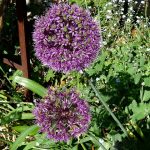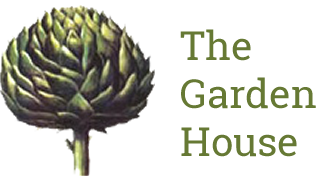Plant of the Month: Allium cristophii
Posted:13 May 2011
The Garden House currently has a stunning display of different kinds of ornamental onions – hundreds of blooms, and flowering around three weeks early!
Our mass plantings include: Allium ‘Mont Blanc’, A. hollandicum ‘Purple Sensation’ AGM, A. atropurpureum, A. nigrum, A. schubertii and our favourite Allium cristophii.
- Common name Star of Persia
- Family – Alliaceae
- Height & spread 30-60cm (12-24in) x 15cm (6in)
- Form Bulbous perennial
- Soil Fertile and well-drained soil
- Aspect Full sun
- Hardiness Fully hardy, but may be tender when young
 The name Allium comes from the ancient name for garlic, which is part of the genus. There are estimated to be around 700 species within the genus, and many cultivars.
The name Allium comes from the ancient name for garlic, which is part of the genus. There are estimated to be around 700 species within the genus, and many cultivars.
Allium mainly come from dry and mountainous areas in the Northern Hemisphere, and have adapted to live in almost every plant habitat, from ice-cold tundra to burning, arid deserts.
There are perennials and biennials, ranging in height from 10cm (4in) to 150cm (5ft) or more – the taller species looking particularly good in groups in a border. After the leaves die back tiny pink-purple star shaped flowers appear clustered together at the top of the stalk, giving this Allium its characteristic ‘lollipop’ look, which in botany is called an umbel.
 Typically they have upright to spreading linear-shaped leaves. The tubular based flowers are bell, star or cup-shaped and are borne in spherical umbels 1cm (3/8in) to 10cm (4in) across. Many take on a metallic colour in early summer.
Typically they have upright to spreading linear-shaped leaves. The tubular based flowers are bell, star or cup-shaped and are borne in spherical umbels 1cm (3/8in) to 10cm (4in) across. Many take on a metallic colour in early summer.
In most species, a single bulb produces clusters of offset bulbs around it, which gradually form clumps. Many Allium give themselves away with the distinctive smell of onions when the bulb or foliage is bruised, and several species have culinary uses, including A. sativum (garlic), culinary onions, shallots and chives.
The Romans are sometimes held responsible for their wide distribution, while the whole group was valued by ancient civilisations as possessing medical and aphrodisiac qualities plus flavour.
Flower stalks dry well and can be used in arrangements or they can be left outside to provide frost-tinged winter interest.
Cultivation:
- Grow in fertile, well-drained soil in full sun
- Plant bulbs 5-10cm (2-4in) deep in autumn
- Plant clump-forming species with rhizomes at or just below the soil surface in spring
- Alliums are susceptible to white rot, downy mildew and onion fly.
Propagation:
- Propagate by offsets, removed when dormant, or by seed in spring at about 13°C (55°F)
- Keep moist and well ventilated, and dry progressively as foliage dies back
- Prick out and pot on when dormant. Seed grown plants, however, may not come true to the parent
- Alternatively, divide clumps of spring-flowering species in summer
The RHS Herbaceous Plant Committee awarded Allium cristophii an Award of Garden Merit (AGM).

